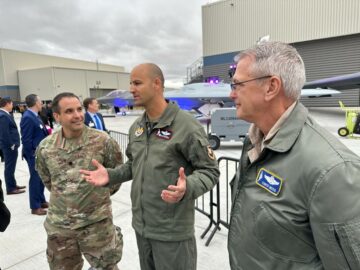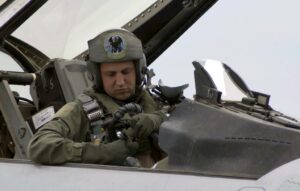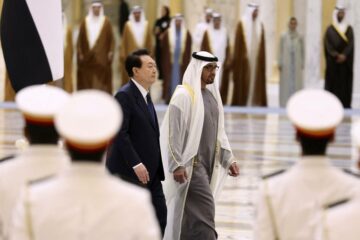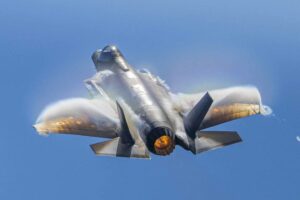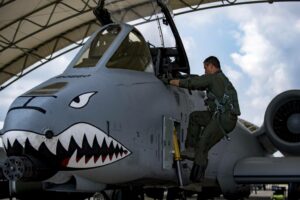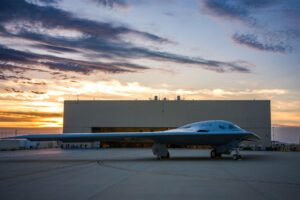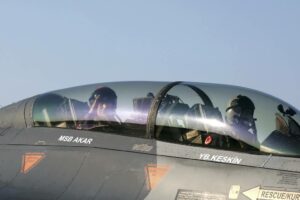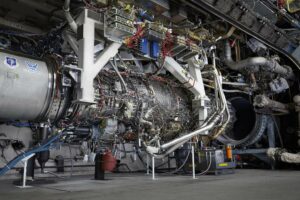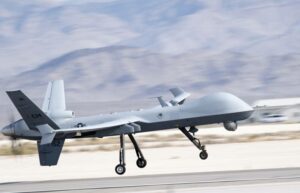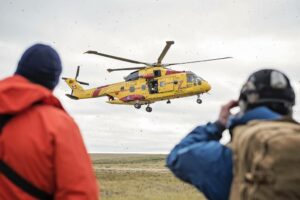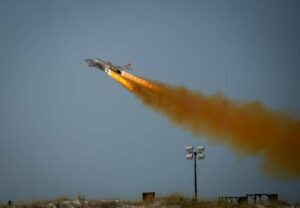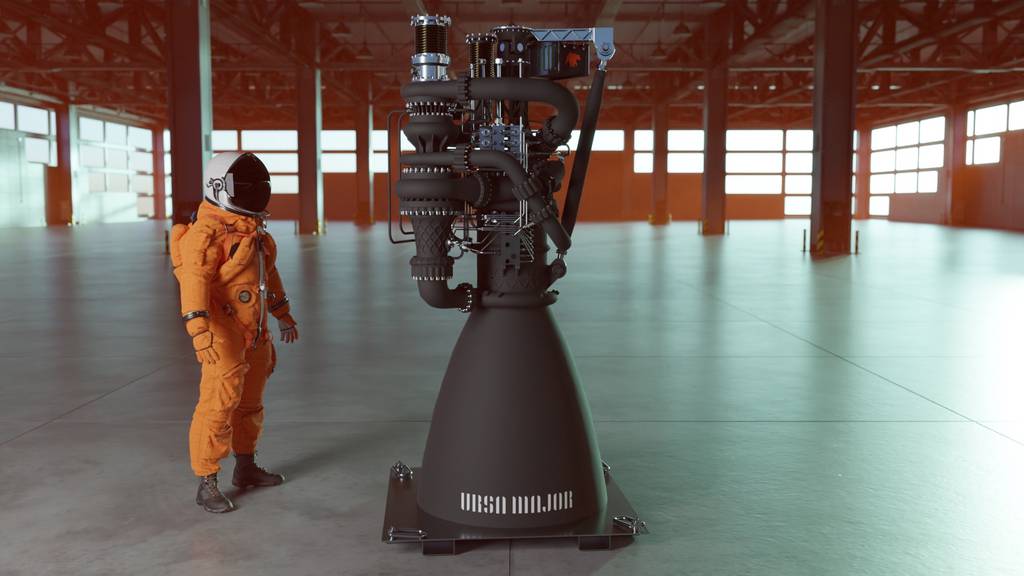
WASHINGTON – The U.S. Air Force Research Laboratory awarded Colorado-based propulsion company Ursa Major a contract to mature two engines, one for space launch and the other for hypersonic launch.
Under the contract, the company will continue the development of its 200,000-pound thrust Arroway engine for space launch, which Ursa Major unveiled in June 2022. Arroway will help replace the Russian-made RD-series engines, according to a company press release. It is a reusable liquid oxygen and methane staged combustion engine for medium and heavy launch vehicles, and the company expects to conduct a hot fire test in 2025.
The contract will also cover the construction and testing of a prototype of the Draper engine for hypersonic launches, which would be a new addition to Ursa Major’s current lineup of three engine models. The company already has a 5,000-pound thrust Hadley engine for hypersonic launches that is currently undergoing certifications for Defense Department use under an August 2022 Air Force contract. Draper would continue this work but use a different liquid propellant that’s more storable — hydrogen peroxide instead of a liquid oxygen and kerosene mix — allowing the reusable engine to be operated safely from more locations.
A Ursa Major statement about the award notes the contract would allow the company to build a dedicated test stand for Draper and hot fire test the engine within 12 months.
The company and the Air Force did not disclose the value of the contract. An Ursa Major spokesman characterized it as an “eight-figure contract.”
“Ursa Major continues to be an important partner to AFRL as we build hypersonics capabilities and remove America’s dependence on foreign propulsion systems for launch,” Shawn Phillips, chief of AFRL’s Rocket Propulsion Division, was quoted as saying in the company news release.
Joe Laurienti, the founder and CEO of Ursa Major, told Defense News in an interview this spring that the military services are pursuing hypersonic missiles and counter-hypersonic defenses, but they still haven’t fully reckoned with the entire infrastructure needed to support those objectives. They’ll need aerial targets for tracking and intercept exercises, they’ll need hypersonic testbeds as they develop various sensors and support equipment for the hypersonic weapons, and they’ll need training missiles as they grow a cadre of hypersonic missile operators, according to Laurienti.
That’s where he thinks Ursa Major and its products — which focus on liquid propellants rather than solid rocket motors — can play the biggest role.
Laurienti said liquid engines have better performance than solid rocket motors but are more difficult to handle and store. The development of the Draper engine gets closer to the ideal balance of the two technologies: as a liquid engine, it will support high speeds, long distances and maneuverable flights, while also being safe enough to fly on the wing of a plane or be stored on a ship.
This combination will be critical as the U.S. builds aerial targets that can simulate threats ranging from Russian hypersonic missiles to Chinese cruise missiles to North Korean and Iranian ballistic missiles.
He also noted the liquid engines can be refilled and reused — but Ursa Major also uses additive manufacturing to keep costs down, meaning the engines will be inexpensive enough to be shot down and destroyed during live-fire tests if needed.
Ursa Major is under contract with hypersonic testing company Stratolaunch to conduct what Laurienti called the the first-ever private hypersonic flight in the U.S. later this year. In this pairing, Stratolaunch has created a reusable cruise missile-like testbed that its customers can use to test their electronics. Ursa Major is providing the engine to propel the testbed to hypersonic speeds.
Laurienti said the company is eyeing other industry pairings like this, hoping Ursa Major can address what he called the “pain point” — propulsion — for private industry interested in hypersonic flights.
But Ursa Major is also eyeing a potential business opportunity with the military. Laurienti said the Air Force and Navy bought and used more than 5,000 AQM-37 air-launched supersonic targets over the course of decades. The services are now looking to replenish their stockpiles and upgrade them from supersonic to hypersonic speed, he explained, an effort that could land the company a seat at the table following the latest engine award.
Megan Eckstein is the naval warfare reporter at Defense News. She has covered military news since 2009, with a focus on U.S. Navy and Marine Corps operations, acquisition programs and budgets. She has reported from four geographic fleets and is happiest when she’s filing stories from a ship. Megan is a University of Maryland alumna.
- SEO Powered Content & PR Distribution. Get Amplified Today.
- PlatoAiStream. Web3 Data Intelligence. Knowledge Amplified. Access Here.
- Minting the Future w Adryenn Ashley. Access Here.
- Buy and Sell Shares in PRE-IPO Companies with PREIPO®. Access Here.
- Source: https://www.defensenews.com/air/2023/05/23/ursa-major-wins-air-force-contract-for-hypersonic-space-launch-engine/
- :has
- :is
- :not
- :where
- 000
- 11
- 12
- 12 months
- 200
- 2022
- 2023
- 2025
- 70
- a
- About
- According
- acquisition
- addition
- additive manufacturing
- address
- AFRL
- AIR
- Air Force
- Air Force Research Laboratory
- allow
- Allowing
- already
- also
- an
- and
- ARE
- AS
- At
- award
- awarded
- Balance
- BE
- being
- Better
- Biggest
- bought
- Budgets
- build
- builds
- business
- but
- called
- CAN
- capabilities
- ceo
- certifications
- characterized
- chief
- chinese
- closer
- Colorado
- combination
- company
- Company news
- Conduct
- construction
- continue
- continues
- contract
- Costs
- could
- course
- cover
- covered
- created
- critical
- cruise
- Current
- Currently
- Customers
- decades
- dedicated
- Defense
- Defense Department
- Department
- dependence
- destroyed
- develop
- Development
- DID
- different
- difficult
- Disclose
- Division
- down
- draper
- during
- effort
- Electronics
- Engine
- Engines
- enough
- Entire
- equipment
- expects
- explained
- Filing
- Fire
- first-ever
- flight
- Flights
- Focus
- following
- For
- Force
- foreign
- founder
- Founder and CEO
- four
- Fourth
- from
- fully
- geographic
- Grow
- handle
- Have
- he
- Headquarters
- heavy
- help
- High
- hoping
- HOT
- HTTPS
- hydrogen
- ideal
- if
- images
- important
- in
- industry
- inexpensive
- Infrastructure
- instead
- interested
- Interview
- Iranian
- IT
- ITS
- jpg
- june
- Keep
- Korean
- laboratory
- Land
- later
- latest
- launch
- launches
- like
- lineup
- Liquid
- locations
- Long
- looking
- major
- manufacturing
- Marine
- Maryland
- mature
- May..
- meaning
- medium
- Megan
- methane
- Military
- missiles
- models
- months
- more
- Motors
- Need
- needed
- New
- news
- news release
- North
- noted
- Notes
- now
- objectives
- of
- on
- ONE
- operated
- Operations
- operators
- Opportunity
- or
- Other
- over
- Oxygen
- pairing
- pairings
- part
- partner
- performance
- plato
- Plato Data Intelligence
- PlatoData
- Play
- potential
- press
- Press Release
- private
- Products
- Programs
- Propel
- propulsion
- prototype
- providing
- ranging
- rather
- release
- remove
- replace
- Reported
- reporter
- research
- reusable
- rocket
- Role
- russian
- s
- safe
- safely
- Said
- saying
- sensors
- Services
- shawn
- she
- shot
- since
- solid
- Space
- speed
- speeds
- spring
- stand
- Statement
- Still
- store
- stored
- Stories
- supersonic
- support
- Systems
- table
- targets
- Technologies
- test
- Testing
- tests
- than
- that
- The
- their
- Them
- they
- Thinks
- this
- this year
- those
- threats
- three
- to
- Tracking
- Training
- two
- u.s.
- U.S. Air Force
- U.S. Navy
- under
- university
- University of Maryland
- upgrade
- use
- used
- value
- various
- Vehicles
- was
- we
- Weapons
- What
- when
- which
- while
- will
- Wing
- Wins
- with
- within
- Work
- would
- year
- zephyrnet

